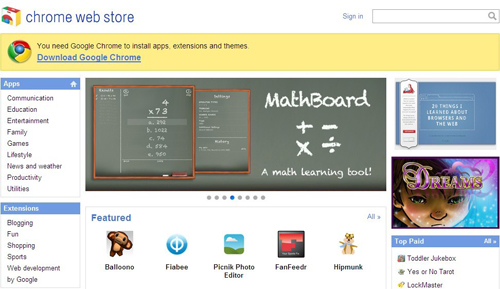谷歌网页应用商店Chrome Web Store遭冷遇
在第三方开发商的千呼万唤中,谷歌的Chrome Web Store终于在2010年12月怯怯地出场了。与TweetDeck、MOG等其他许多网页应用商店一样,Chrome Web Store也支持用户在线购买和安装网页应用,它也是首先使用统一计费系统的应用商店之一(它采用Google Checkout),据称还将与谷歌Chrome浏览器牢牢地绑定在一起。但据游戏邦所知,这个应用商店现在仍然是门前冷落鞍马稀,根本没有多少客流量。
Chrome Web Store的UI与苹果iTunes非常相似,并效仿后者设置了一个“顶级付费应用”列表。目前这个列表中排行第一的是Toddler Jukebox,售价1.99美元,主要功能却是播放12岁小孩的儿歌。从该应用商店的统计情况来看,它在本周的下载量不过6次而已。
公平地说,谷歌设置这个列表很可能不是为了推销产品,因为该列表上还有其他一些应用的销量就比Toddler Jukebox略为可观,虽然其实还是很不理想。该列表上最近销售情况最好的是MathBoard,每周下载量达65次,零售价是2.99美元(如果算上谷歌抽成的话,它的实际收益应该是2.56美元)。换句话说,它一周内总收入是165美元。虽然实在是少得可怜,但也总比其他颗粒无收的应用要强得多。
另外圣诞假期过后,这个应用商店就更加冷清了,游戏邦认为有一个重要原因就是:谷歌对这个网页应用商店的推广力度太小。Chrome刚发布的时候也没有向市场重点推介Chrome Web Store,除非用户亲访问该应用商店才能见识它的真容。谷歌很有必要在一些网站上多打打横幅广告,增加它的曝光率,才不会让这个应用商店的出世显得遮遮掩掩,神神秘秘。
这个应用商店有一些免费应用下载量相对更多一些,比如Quick Note,本周下载安装次数是8000。免费应用一直是比付费应用更有市场,所以这一点也不足为奇,只不过65次的付费下载量比起8000次的免费安装量,这个差距实在是太明显了。
由此可见,谷歌网页应用商店还有很多问题需要解决。另外,它的付费流程也太简单、太缺乏安全性了(只要你有一个Google Checkout帐号,轻点两次鼠标就能完成付费),谷歌最好提供更多透明信息,让用户了解自己所购买的产品属性。(本文为游戏邦/gamerboom.com编译,转载请注明来源:游戏邦)
Sales Have Slowed To A Trickle On Google’s Chrome Web Store
In December, after months of anticipation and discussions with third-party developers, Google finally unveiled the Chrome Web Store — an online portal that lets users purchase and ‘install’ web applications like TweetDeck, MOG, and hundreds of others. It’s one of the first platforms that helps developers monetize web applications using a unified payment system (in this case, Google Checkout), and it’s going to be deeply integrated into Google’s Chrome browser. Unfortunately, as far as we can tell, nobody is really buying anything on it.
The UI for the Chrome Web Store looks very similar to iTunes, and, just like iTunes, one of the most prominent sections is a list of ‘Top Paid’ applications. Sitting at the top of the list is
Toddler Jukebox, a colorful little app selling for $1.99 that lets you play twelve children’s songs, like ‘Wheels on the Bus’. And, according to the Web Store stats, it’s been installed six times this week. Ouch.
To be fair, Google isn’t sorting its ‘Top Paid’ list in order of purchases (though I’m not sure why) — a few of the other applications in the list are doing better, but even those are still showing lackluster sales. The paid application with the most recent activity is MathBoard, which has 65 weekly installs and sells for $2.99 (less Google’s fees, so it gets around $2.56 a pop).
In other words, it’s earning around $165 a week. That’s not nothing, but given that every other app on the store is probably making less than that, it’s not good.
Now, it’s possible that sales slowed a bit over the holidays, but the impact couldn’t have been that huge. There is, however, one more significant explanation for this: Google hasn’t done much to expose the Web Store to users. In fact, the current stable release of Chrome still doesn’t actually feature the Chrome Web Store anywhere — it only shows up if you go to the Web Store directly and install an application. That said, Google has placed banner ads for the Store on some sites (including TechCrunch), and the store got loads of publicity at launch, so it’s not like it’s a secret.
There are some free applications that are getting far more attention, like Quick Note, which has 8,000 installs this week. Obviously it’s common for free applications to get more installations than premium apps, but the discrepancy — 65 paid installs versus 8,000 free — seems pretty steep.
One thing is clear: Google has a long way to go with the Web Store. It’s still impossible to distinguish applications that are basically just bookmarks from those that are full-fledged web apps. And while the purchase flow itself is pretty simple (you can buy something in a couple clicks, assuming you already have a Google Checkout account), I think Google will have to put some work into educating people on what exactly they’re paying for.(source:techcrunch)








































 闽公网安备35020302001549号
闽公网安备35020302001549号